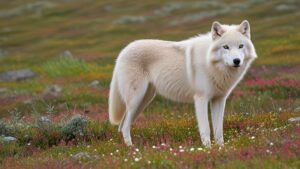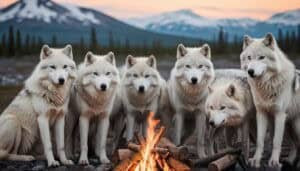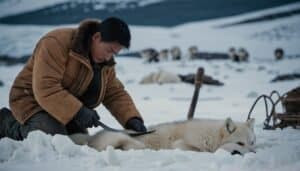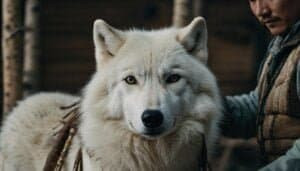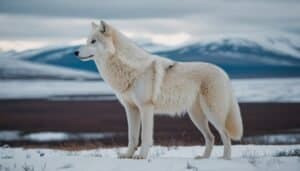Introduction
Tracking Arctic wolves is both a skillful art and a science, deeply rooted in the traditions of Arctic hunters. For Indigenous communities, particularly the Inuit, this practice is essential for subsistence and survival in the unforgiving tundra
By studying tracks, scat, and other signs, hunters gain critical insights into the behavior and movements of these elusive predators. Today, modern technologies like GPS complement traditional knowledge, enhancing tracking accuracy in the vast Arctic wilderness
This article delves into the traditional and modern techniques used to follow Arctic wolves, the challenges hunters face, and the vital role this practice plays in understanding and conserving Arctic ecosystems
Techniques for Tracking Arctic Wolves
Tracking Arctic wolves requires a deep understanding of the tundra environment, wolf behavior, and survival skills honed over generations
Arctic hunters, particularly Indigenous communities such as the Inuit, employ a blend of traditional methods and modern technologies to locate and follow these elusive predators across harsh, frozen landscapes
Traditional Tracking Methods Used by Arctic Hunters
Traditional tracking relies on acute observational skills and an intimate knowledge of the Arctic’s ecosystems
Hunters carefully analyze footprints in the snow, identifying details such as stride length, claw marks, and depth of the track. These observations help determine the size, age, and direction of the wolf, offering clues about its behavior and health
Arctic hunters also rely on other natural indicators, such as the presence of scat, which can reveal the wolf’s diet and recent activity. Prey remnants like bones or partially eaten carcasses provide additional evidence of wolf presence in an area. The ability to interpret these signs accurately is passed down through generations, forming the cornerstone of traditional ecological knowledge
Hunters understand the seasonal movements of Arctic wolves, which often follow migratory prey such as caribou. This knowledge enables them to predict where wolves might be found, particularly during critical times like hunting or denning seasons
Modern Tools in Arctic Wolf Tracking
While traditional methods remain essential, modern technology has enhanced tracking accuracy and efficiency
Tools like GPS devices and satellite imagery allow hunters to map their routes and record wolf locations with precision. These devices are particularly valuable in documenting the vast distances covered by wolves in the Arctic
Camera traps have become another invaluable tool, capturing images of wolves as they pass through specific areas. These devices provide insights into wolf pack composition, behavior, and habitat use, contributing to both hunting practices and conservation efforts
Programs such as the Igliniit initiative integrate GPS with Indigenous knowledge, equipping hunters with tools to monitor not only wolves but also broader environmental changes. This fusion of technology and tradition ensures that Arctic communities can adapt to shifting landscapes while preserving their cultural practices
Differences Between Wolf Tracks and Other Animals
Distinguishing Arctic wolf tracks from those of other animals is a critical skill for hunters. Wolf tracks are generally larger than those of dogs or foxes, with a more oval shape and prominent claw marks. The stride length of wolves also tends to be longer, reflecting their efficient and purposeful movement across the tundra
Hunters pay close attention to the spacing and depth of tracks. A single wolf’s tracks might appear solitary, but pack movements often create overlapping patterns that indicate group travel. By contrast, tracks of prey animals like caribou are cloven and show distinct gait patterns associated with grazing or fleeing behavior
Recognizing these differences is not just about identifying wolves; it also helps hunters understand the dynamics of predator-prey interactions and locate areas where wolves are likely to hunt
Understanding Arctic Wolf Behavior During Tracking
To successfully track Arctic wolves, hunters must have a deep understanding of their behavior and movement patterns
This knowledge, rooted in years of observation and experience, allows hunters to anticipate wolf activity, increasing their chances of locating these elusive predators in the vast tundra
How Pack Dynamics Influence Tracking Success
Arctic wolves are highly social animals that live and hunt in packs, a behavior that significantly impacts their movement and activity patterns
Packs are typically led by an alpha pair, whose decisions dictate the group’s travel, hunting, and resting habits. Hunters observe pack dynamics through track analysis, looking for signs of coordinated movement, such as parallel trails that indicate multiple wolves traveling together
The presence of pups can also influence pack behavior. During the denning season, wolves stay closer to their dens to protect and nurture their young. Hunters with knowledge of seasonal patterns and denning sites can focus their tracking efforts in these areas to maximize success
Understanding wolf hierarchy is another critical factor. Subordinate wolves may split from the pack to scout for prey or avoid conflict, leaving solitary tracks that can provide misleading information. Skilled hunters use this knowledge to distinguish between lone wolves and pack movements
Recognizing Key Signs Like Scat and Prey Remains
Scat is a valuable clue in wolf tracking. By analyzing the size, shape, and content of scat, hunters can gather information about a wolf’s diet, health, and even recent movements. For instance, scat containing fur or bones indicates recent feeding, while plant matter might suggest a period of food scarcity
Prey remains, such as carcasses or partially consumed animals, are another critical indicator. Arctic wolves primarily hunt caribou, musk oxen, and Arctic hares, leaving behind distinct signs of their feeding behavior. By examining these remnants, hunters can deduce the presence of wolves and gauge their activity in a given area
Hunters also note other signs, such as claw marks on trees or rocks, which may indicate territorial markings. These subtle clues, combined with footprints and other evidence, create a detailed picture of wolf activity
Using Traditional Ecological Knowledge for Better Accuracy
Traditional ecological knowledge (TEK) is an invaluable resource for tracking Arctic wolves. Indigenous hunters have accumulated generations of insights into the behavior and ecology of these predators, enabling them to make accurate predictions about wolf movements and habitat preferences
For example, TEK includes an understanding of how wolves adapt to seasonal changes, such as the migration patterns of prey animals or the effects of severe weather. This knowledge allows hunters to adjust their strategies accordingly, focusing on areas where wolves are most likely to be active
TEK also emphasizes the importance of observing the environment as a whole. Changes in prey behavior, weather patterns, or even the condition of snow can all provide clues about wolf activity
This holistic approach ensures that hunters remain attuned to the complexities of the Arctic ecosystem
Challenges in Tracking Arctic Wolves
Tracking Arctic wolves is a demanding task that requires resilience, expertise, and adaptability. Hunters must navigate extreme weather, rugged terrain, and environmental changes while maintaining precision and patience
These challenges underscore the difficulty of following one of the Arctic’s most elusive predators
Environmental Factors Affecting Tracking
The Arctic tundra presents a unique set of environmental obstacles. Blizzards, subzero temperatures, and high winds can quickly erase tracks or make them indistinguishable, hindering even the most skilled trackers
Additionally, the uniformity of the landscape often complicates navigation, requiring hunters to rely on landmarks, memory, and GPS devices to avoid disorientation
Snow conditions play a crucial role in tracking success. Fresh, powdery snow reveals clear footprints, while hard-packed or icy surfaces can obscure tracks entirely. Melting snow during seasonal transitions adds further complexity, as tracks can become distorted or disappear altogether
Short daylight hours in winter also limit tracking opportunities, forcing hunters to maximize efficiency during the brief periods of light
Impact of Climate Change on Wolf Movement Patterns
Climate change has introduced significant challenges to traditional tracking methods. Rising temperatures and shrinking ice cover are altering the behavior of Arctic wolves and their prey. For instance, caribou migration patterns, a key factor in predicting wolf activity, are shifting in response to changing vegetation and weather conditions
Moreover, the thawing of permafrost and increased human activity in the Arctic are fragmenting wolf habitats, causing packs to adjust their ranges
These changes make it harder for hunters to anticipate wolf movements based on historical patterns, emphasizing the need for adaptive tracking strategies
A 2021 study published in Nature Climate Change highlights how these disruptions are likely to intensify, further complicating tracking efforts. Hunters and researchers are working together to document these shifts and develop new methods to stay ahead of the changes
Navigating Remote and Harsh Arctic Terrain
The remoteness of the Arctic tundra adds another layer of difficulty to tracking wolves
Hunters often travel long distances by sled or snowmobile, carrying limited supplies and relying on their survival skills to endure the harsh conditions. Fuel, food, and shelter must be carefully managed to avoid exhaustion or danger
Encounters with other wildlife, such as polar bears, also pose risks, requiring hunters to remain vigilant at all times. Additionally, the physical toll of traversing such unforgiving terrain can test even the most experienced individuals
Despite these challenges, Arctic hunters continue to refine their techniques, blending traditional knowledge with modern tools to track wolves effectively. Their perseverance not only supports subsistence hunting but also contributes to broader conservation efforts by providing valuable data on wolf populations and behavior
Conclusion
Tracking Arctic wolves is a remarkable blend of traditional knowledge and modern technology, showcasing the resilience and ingenuity of Arctic hunters
Indigenous communities, such as the Inuit, have honed their skills over generations, relying on their understanding of wolf behavior, pack dynamics, and environmental cues to follow these elusive predators across the tundra
These traditional methods are complemented by advanced tools like GPS, satellite imagery, and camera traps, which enhance tracking accuracy and efficiency
However, the practice faces significant challenges. Harsh environmental conditions, the remoteness of the Arctic terrain, and the impacts of climate change all complicate tracking efforts. The shifting migration patterns of prey animals and habitat fragmentation further highlight the need for adaptable strategies
Despite these obstacles, Arctic hunters continue to track wolves with remarkable success, contributing not only to their own survival but also to broader conservation efforts
By integrating traditional ecological knowledge with cutting-edge technology, they provide valuable insights into Arctic ecosystems, helping to ensure the preservation of both the wolves and the landscapes they inhabit


